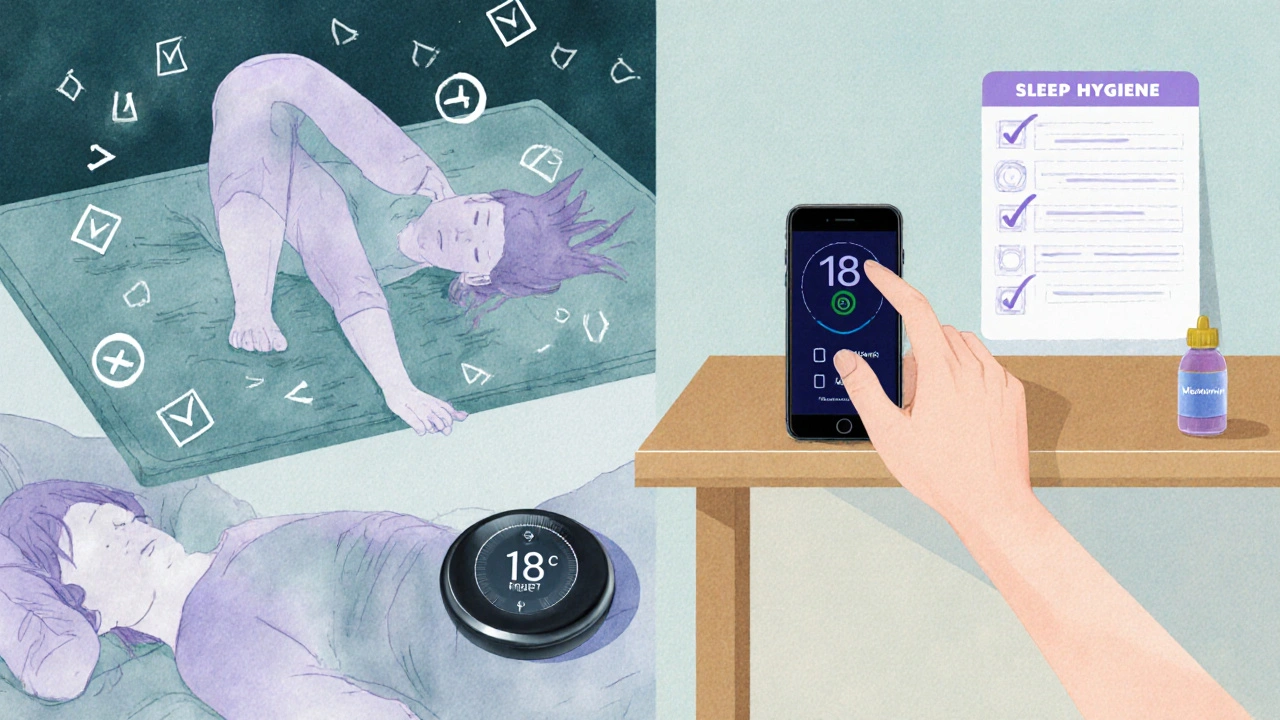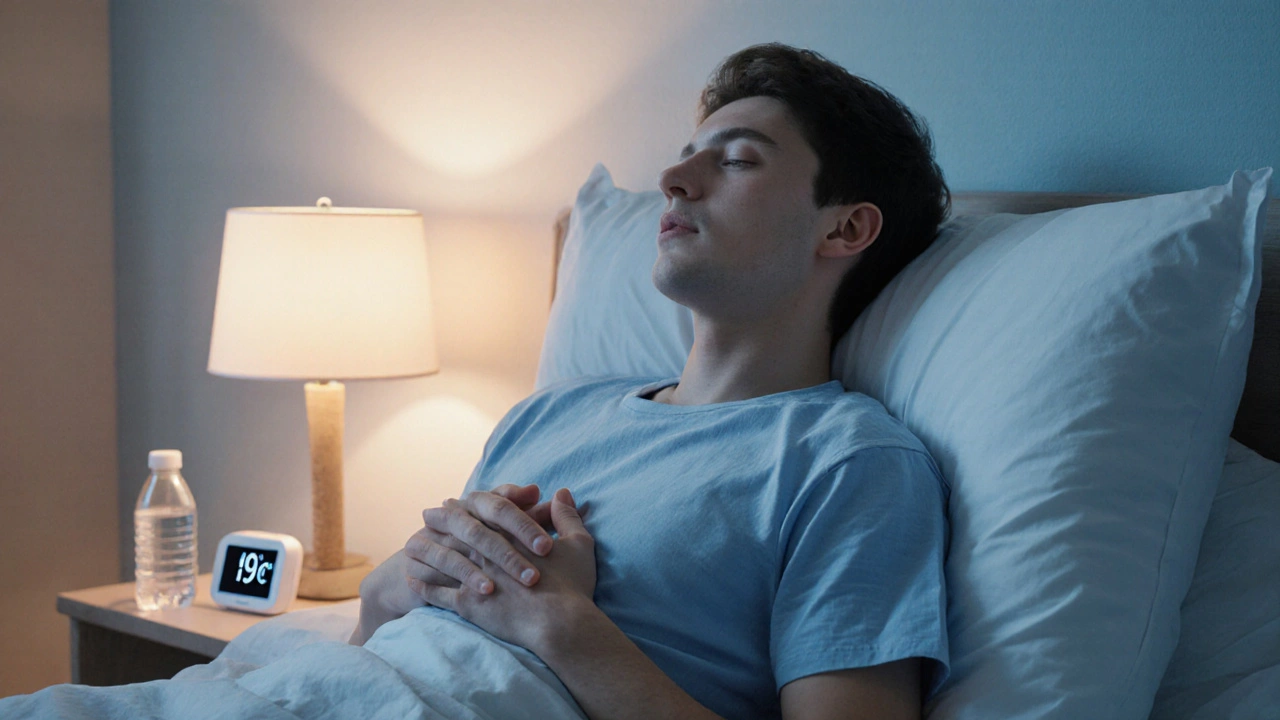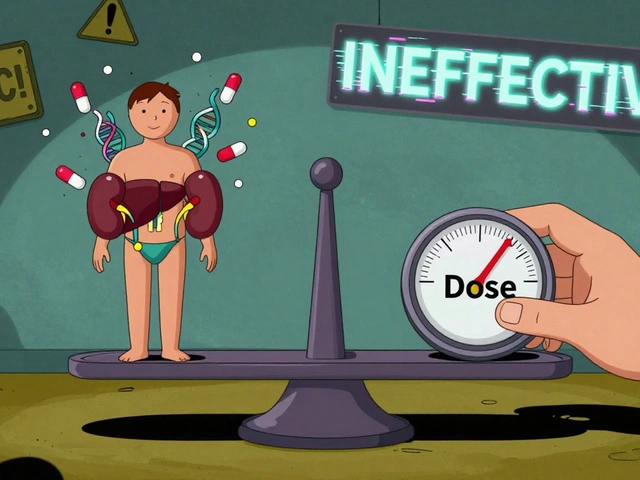Hodgkin's Disease Sleep Hygiene Tracker
Tonight's Sleep Tips
- Keep your bedroom cool (18-20°C)
- Avoid screens 1 hour before bed
- Practice deep breathing or gentle stretches
- Take medications as prescribed
- Log any sleep disruptions
Common Sleep Challenges
- Insomnia from treatment side effects
- Disrupted circadian rhythms
- Medication-induced fatigue
- Stress and anxiety about recurrence
- Temperature fluctuations
Nightly Sleep Checklist
Mark each task as completed once you've finished it:
Sleep Pattern Timer
Sleep Improvement Tips
Based on your progress, consider these evidence-based improvements:
- Try progressive muscle relaxation if you struggle with tension
- Use blackout curtains or eye masks for better darkness
- Keep a consistent bedtime routine even when traveling
- Consider light therapy in the morning to regulate your circadian rhythm
- Keep a sleep diary to spot patterns in your sleep quality
For anyone dealing with Hodgkin's disease, quality sleep is essential to cope with treatment and maintain overall health.
Key Takeaways
- Hodgkin's disease often disrupts sleep through fatigue, pain, and treatment side‑effects.
- Adopting specific sleep‑hygiene habits can improve rest without interfering with therapy.
- Targeted strategies such as timing of chemotherapy, managing nighttime pain, and using melatonin safely are effective.
- Know when to call a medical professional - persistent insomnia, extreme daytime drowsiness, or new neurological symptoms need attention.
- A simple nightly checklist helps turn good intentions into consistent actions.
What is Hodgkin's Disease?
Hodgkin's disease is a type of lymphoma that originates in the lymphatic system, most often affecting B lymphocytes. It typically presents as painless swelling of lymph nodes, fever, night sweats, and unexplained weight loss. Modern chemotherapy and radiation protocols have turned many cases into long‑term survivorship, but the disease and its treatments can throw sleep patterns off balance.
Why Sleep Gets Disrupted
Several physiological and psychological factors linked to Hodgkin's disease interfere with a good night’s rest:
- Fatigue is a hallmark symptom, often described as a heavy, unrefreshing tiredness that persists despite sleeping.
- Side‑effects from chemotherapy (nausea, neuropathy, hormone shifts) can cause frequent awakenings.
- Radiation therapy to the chest or neck may lead to inflammation that worsens coughing or heartburn at night.
- Psychological stress-fear of recurrence, anxiety about test results-activates cortisol, making it harder to wind down.
- Changes in the immune system’s signaling can disturb the circadian rhythm, leading to delayed sleep phase or early morning awakenings.
Typical Sleep Problems in Hodgkin's Patients
While every individual’s experience varies, the most common complaints are:
- Insomnia - difficulty falling or staying asleep.
- Fragmented sleep due to pain or medication‑induced night sweats.
- Daytime drowsiness that interferes with daily activities and treatment schedules.
- Altered sleep architecture (less deep REM sleep) caused by chemotherapy‑related neurochemical shifts.

Evidence‑Based Sleep Hygiene for Hodgkin's Disease
Below are concrete, low‑cost actions that fit well with oncology care plans. Each tip is backed by research on cancer‑related insomnia or general sleep physiology.
- Set a consistent bedtime and wake‑time. Even on weekends, a 30‑minute window helps reset the circadian clock.
- Limit screen exposure. Blue‑light from phones suppresses melatonin. Use night‑mode settings or keep devices out of the bedroom after 9p.m.
- Create a calming pre‑sleep routine. Gentle stretching, deep‑breathing, or reading a paperback for 15minutes signals the body it’s time to relax.
- Manage bedroom temperature. Aim for 18‑20°C (65‑68°F). Cooler rooms promote deeper sleep stages.
- Watch fluid intake. Reduce caffeine after noon and limit liquids in the evening to avoid nighttime bathroom trips.
- Address pain proactively. Discuss with your oncologist the best timing for analgesics so they wear off before bedtime.
- Time chemotherapy wisely. If possible, schedule infusions earlier in the day. Late‑day sessions can spike fatigue and disrupt night sleep.
- Consider melatonin supplementation. A low dose (0.5‑3mg) taken 30minutes before bed can help reset the sleep‑wake cycle, but always get clearance from your medical team.
Managing Treatment Side‑Effects for Better Rest
Specific strategies for the most common treatment‑related sleep disruptors:
- Nausea and vomiting. Anti‑emetic meds taken 30minutes before bedtime reduce the need to get up.
- Neuropathy. Cooling gloves or socks at night can ease tingling sensations that otherwise keep you awake.
- Hormonal changes. Steroid pulses (e.g., dexamethasone) often cause insomnia. Ask your doctor about tapering or a short‑acting bedtime dose of a sleep aid.
- Night sweats. Light, breathable fabrics and a fan can cut down on temperature spikes.
When to Seek Professional Help
If any of the following occur, contact your oncology team or a sleep specialist promptly:
- Insomnia persists for more than two weeks despite hygiene changes.
- Daytime sleepiness interferes with chemotherapy appointments or daily living.
- New neurological symptoms (headaches, visual changes, severe dizziness) appear.
- Sleep disturbances worsen after a new medication is added.
Quick Nightly Checklist
| Task | Why It Matters | Time of Day |
|---|---|---|
| Adjust room temperature | Promotes deep REM cycles | 30min before bed |
| Take prescribed pain/anti‑emetic meds | Prevents night‑time awakenings | According to prescription schedule |
| Turn off screens / use night‑mode | Allows melatonin production | 1hour before bed |
| Practice breathing or gentle stretch | Reduces cortisol spikes | 15min before bed |
| Log any night sweats or pain spikes | Helps clinician adjust treatment | Each awakening |
Frequently Asked Questions
Can Hodgkin's disease itself cause insomnia?
Yes. The disease alters immune signaling and often brings night sweats, both of which can interrupt sleep. Stress about the diagnosis also raises cortisol, a hormone that keeps you alert.
Is melatonin safe while undergoing chemotherapy?
Generally, low‑dose melatonin is considered safe, but it can interact with certain drugs that affect blood clotting. Always run it by your oncologist before starting.
How many hours of sleep should I aim for?
Most adults need 7‑9 hours, but patients battling fatigue may benefit from short naps (20‑30minutes) earlier in the day without compromising nighttime sleep.
What should I do about night sweats?
Dress in layers, keep a fan nearby, and use moisture‑wicking sheets. If sweats become severe, your doctor may adjust steroid dosing.
Can exercise improve my sleep?
Light to moderate activity (e.g., walking, yoga) for 30minutes most days boosts fatigue resistance and helps regulate the circadian rhythm, but avoid vigorous workouts close to bedtime.




Karen Wolsey
October 5, 2025 AT 01:41Great, another bedtime routine – because we all love more checklists.
Trinity 13
October 5, 2025 AT 09:28Alright, let’s dive into why a solid sleep routine can actually feel like a rebellion against the chaos chemo brings.
First off, the body craves predictability, especially when the immune system is doing somersaults from the treatment.
If you set a strict bedtime, you’re giving your circadian clock a clear cue, and that clock is the unsung hero that decides whether you’ll wake up feeling like a zombie or a semi‑functioning human.
Second, turning off screens an hour before lights out isn’t just a trendy suggestion-it’s a hardcore move to stop blue light from hijacking melatonin production.
You might think, “I need to check my messages,” but trust me, those notifications will only amplify cortisol, the stress hormone that loves to keep you wired.
Third, temperature matters; a cool bedroom mimics the drop in core temperature that naturally occurs when you drift into deep sleep stages.
If you’re sweating like you’re in a sauna because of night‑sweats, a fan or breathable sheets can be a game‑changer.
Now, let’s talk meds: timing your painkillers so they wear off right before you hit the pillow prevents those midnight awakenings that shred any sense of rest.
And don’t forget that steroid pulses are notorious sleep thieves, so a low‑dose bedtime aid, approved by your oncologist, can smooth out those spikes.
I get it, life with Hodgkin’s feels like a marathon where the finish line keeps moving, but consistency in these tiny habits stacks up like compound interest.
Your checklist is a brilliant visual cue, but the magic happens when you actually log those night‑time disruptions and bring them to your doctor.
Data isn’t just for research papers; it’s a personal map that tells you what’s working and what needs a tweak.
If you’re still tossing, consider a brief 20‑minute nap early in the day-just don’t let it creep past 3 p.m. or you’ll sabotage your nighttime sleep.
Light therapy in the morning can also push your internal clock forward, making it easier to fall asleep when the lights go out.
Finally, be kind to yourself; perfection isn’t the goal, progress is.
Stick with it, adjust as you go, and you’ll see those restless nights start to turn into actual, restorative sleep.
faith long
October 5, 2025 AT 14:11Listen up, because this isn’t a gentle nudge, it’s a full‑blown wake‑up call for anyone thinking they can coast through Hodgkin’s without a solid sleep strategy.
First, the fatigue you feel isn’t just “being tired,” it’s a physiological signal that your body is fighting on multiple fronts – cancer, chemo, radiation, and the emotional roller‑coaster that comes with it.
Ignoring that signal is tantamount to sabotage; you’ll only make treatment side‑effects worse and prolong recovery.
Second, the night‑sweats and temperature swings aren’t optional accessories – they’re a direct outcome of cytokine storms triggered by therapy, and they’ll wreck any chance of deep REM if you don’t control the environment.
Set that thermostat between 18‑20°C, invest in breathable linens, and keep a fan handy – don’t just “hope for the best.”
Third, your medications have a pharmacokinetic profile that can be tweaked – talk to your oncologist about timing painkillers so they peak when you’re already in bed, not at 2 a.m. when they’ll jolt you awake.
If steroids are part of the regimen, demand a tapering schedule or a low‑dose hypnotic at night – otherwise you’ll be staring at the ceiling for hours.
The mental load is equally brutal; cortisol spikes from anxiety are a death‑sentence for melatonin production.
Implement a pre‑sleep ritual – breathing, light stretching, reading a paperback – and stick to it like a drill sergeant.
Keep a simple log of every interruption, every night‑sweat episode, every dose of meds; this data is gold when you sit down with your care team.
Don’t be fooled by the “nap when you’re sleepy” advice – limit daytime naps to 20‑30 minutes before 3 p.m. to avoid wrecking your night‑time sleep drive.
Consider light therapy in the morning to reinforce the circadian rhythm, especially if your chemo schedule sucks your energy in the afternoons.
And for the love of all things holy, if insomnia drags on more than two weeks, get a referral to a sleep specialist – you’re not being dramatic, you’re being proactive.
Remember, sleep is not a luxury, it’s a treatment adjunct that can improve response rates and quality of life.
So, stop treating it like an afterthought and start commanding it like the critical component of your recovery it truly is.
Adam Khan
October 5, 2025 AT 19:44From a linguistic precision standpoint, the checklist employs a hierarchical ontology that aligns with sleep‑hygiene protocols, thereby facilitating cognitive encoding.
However, the semantic load of terms like “night sweats” and “chemotherapy‑induced fatigue” necessitates contextual scaffolding to avoid epistemic confusion.
Incorporating pharmacokinetic timing variables into the schedule would augment the functional granularity of the regimen.
Furthermore, deploying a circadian rhythm model (e.g., the Kronauer model) could predict optimal sleep windows based on treatment cycles.
Overall, the document is structurally sound, but a few jargon‑heavy augmentations would elevate its efficacy.
rishabh ostwal
October 5, 2025 AT 23:54While the advice is undeniably practical, one must not overlook the existential dimension of confronting a malignancy.
Sleep, in this context, becomes an act of defiance against the physiological chaos imposed by oncologic interventions.
Yet, the prescriptive tone may inadvertently suppress individual agency, which is paramount in navigating such a tumultuous journey.
Therefore, I propose a dialectical synthesis: adhere to the regimen while simultaneously interrogating its underlying assumptions.
Kristen Woods
October 6, 2025 AT 05:44Deaer team,
I have reviewed teh document and I must say it is very well contructed.
However, there are some inconsitencies in the date format that caauses confusion.
Please ensure all sections use the same datte style and verify that the widow of the thermometer is set correctly.
Thank you for your atention.
Carlos A Colón
October 6, 2025 AT 09:04Well, if we’re going to criticize the typo‑fest, at least we can agree the core advice is solid – even if it looks like it was typed during a midnight panic.
Aurora Morealis
October 6, 2025 AT 13:31Sleep hygiene is crucial. Keep the room cool. Log any disturbances.
Sara Blanchard
October 6, 2025 AT 17:08Every person’s experience is unique, so feel free to adapt the checklist to what truly works for you while staying safe.
Anthony Palmowski
October 6, 2025 AT 22:24Okay, listen up, folks-this checklist is great, but you’ve got to actually use it, otherwise it’s just a pretty piece of HTML, right?; you need to set that thermostat, you need to turn off those damn phones, you need to actually take your meds on schedule, and you need to log those night sweats, because if you don’t, how the heck will your doctor know what’s going on?; also, don’t forget the fan-seriously, a fan can be a lifesaver, especially when the chemo makes you feel like you’re sitting in a sauna; finally, remember that consistency beats occasional effort every single time, period.
Jillian Rooney
October 7, 2025 AT 01:28In my opnion, the suggstion to keep a consistent bedtime is madly importnt, especially when you are facinng a dangeorus disease like Hodgkin’s.
Rex Peterson
October 7, 2025 AT 06:11Contemplating the interplay between circadian biology and oncologic therapy reveals a profound truth: rest is not merely a respite, but a reparative process integral to cellular recovery.
Candace Jones
October 7, 2025 AT 10:04Stick to the temperature tip and log your night sweats; it really helps your care team fine‑tune treatment.
Robert Ortega
October 7, 2025 AT 12:51That’s solid advice – monitoring environment and symptoms can only improve communication with clinicians.
Elizabeth Nisbet
October 7, 2025 AT 17:51Remember, you’re not alone in this; lean on your support network, and keep the routine simple so it becomes a habit, not a chore.
Sydney Tammarine
October 7, 2025 AT 23:24Oh, the drama of trying to sleep while your body stages a nightly protest! 🌙✨ Let’s be honest, the checklist is practically a script for a thriller – temperature wars, medication cliffhangers, and the ever‑present night‑sweat villain. But darling, you’ve got the power to rewrite the ending, one cool breath at a time. 😌